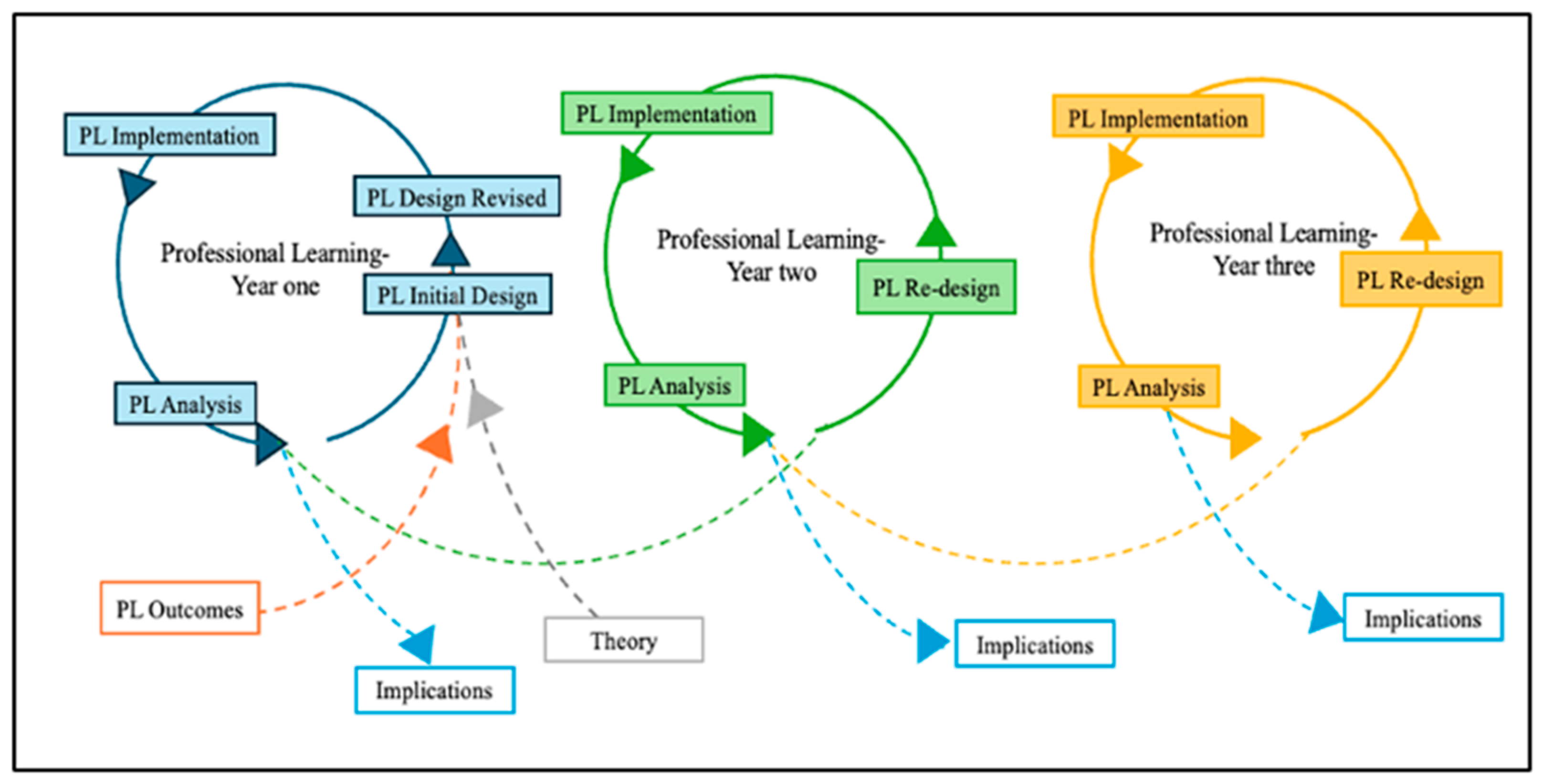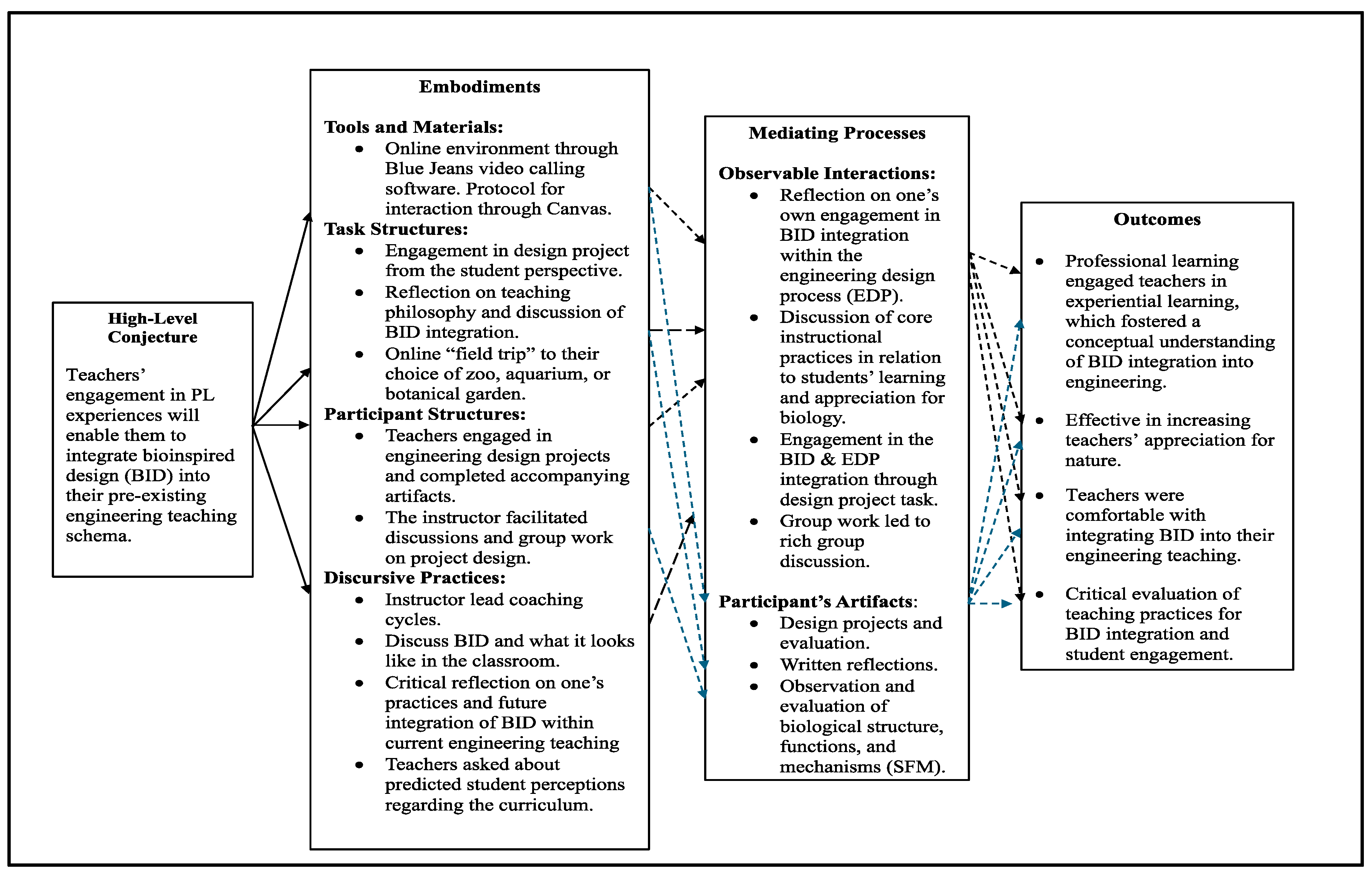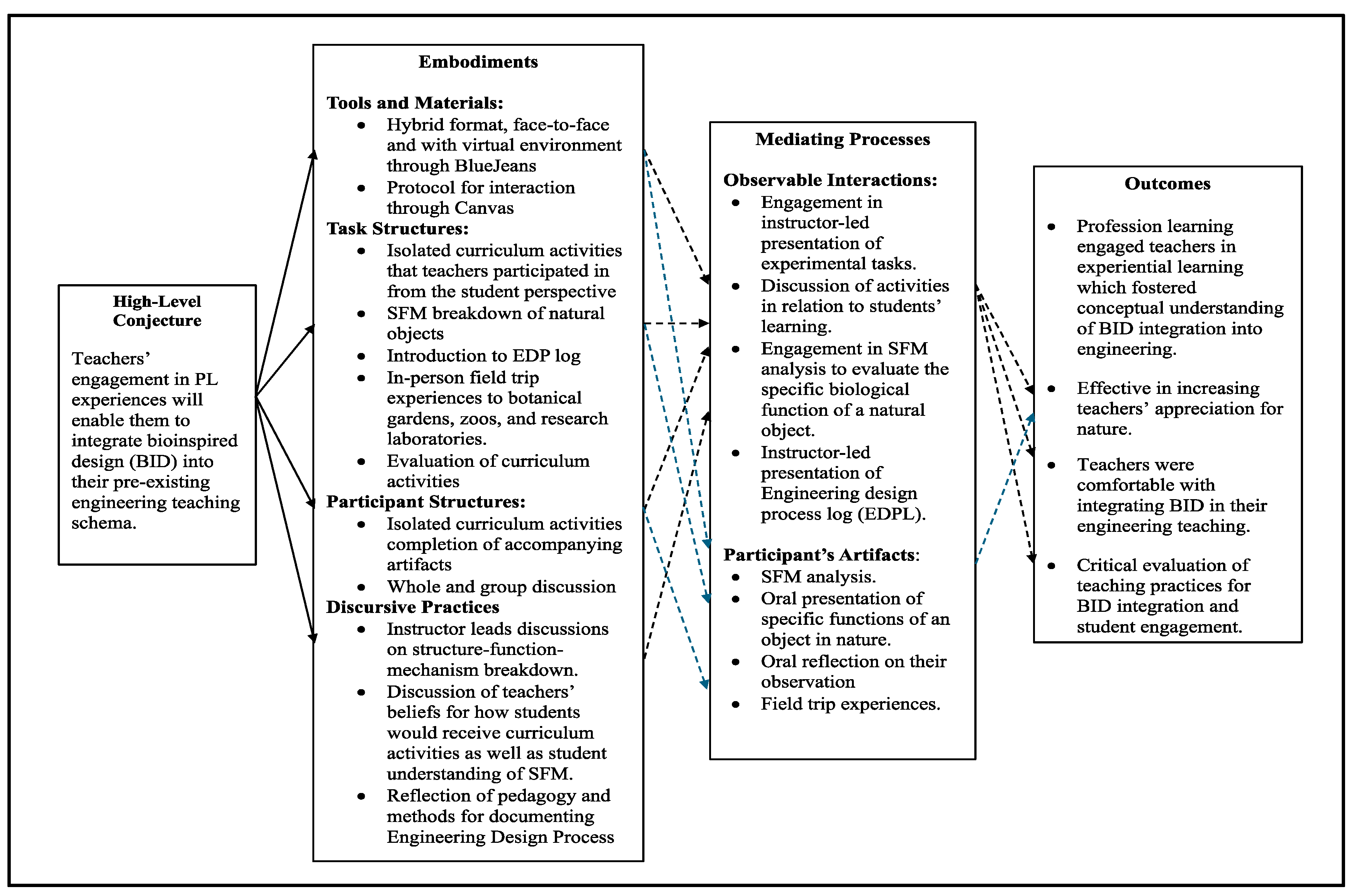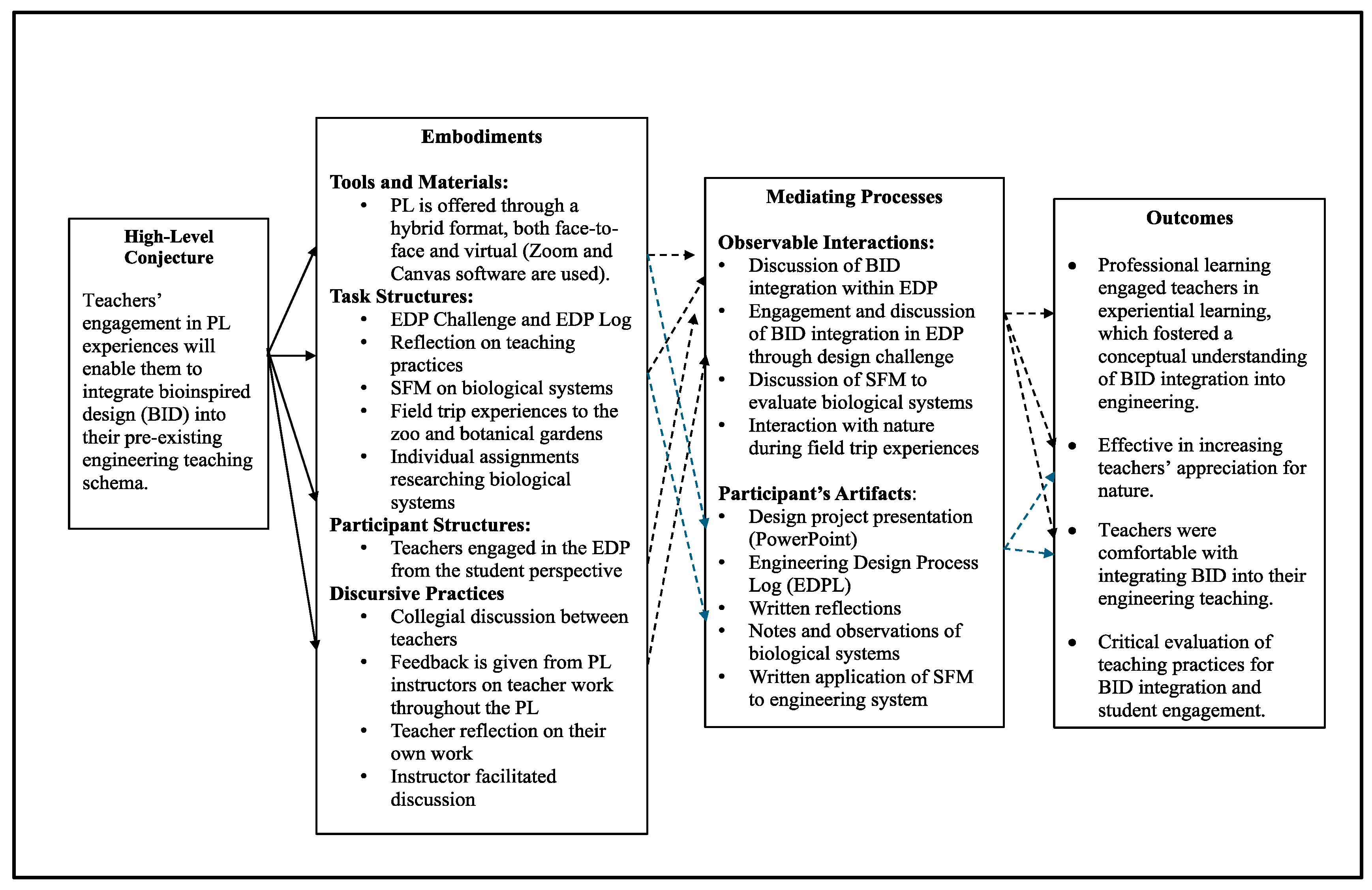Examining an Evolving Biologically Inspired Design Professional Learning Environment through Conjecture Mapping and Design-Based Research
Abstract
1. Introduction
2. Background
2.1. Professional Learning Experiences
2.2. Purpose
2.3. Methodological Background
2.3.1. Design-Based Research (DBR)
2.3.2. Conjecture Mapping
2.3.3. Integration of DBR and Conjecture Mapping
3. Materials and Methods
3.1. Participants and Settings
3.2. Context: Professional Learning
3.3. Data
3.4. Analysis: Combined DBR and Conjecture Mapping Process
4. Results
4.1. Professional Learning Year One
4.2. Professional Learning Year Two
4.3. Professional Learning Year Three
5. Discussion
6. Conclusions
7. Limitations
Author Contributions
Funding
Institutional Review Board Statement
Informed Consent Statement
Data Availability Statement
Acknowledgments
Conflicts of Interest
References
- Fu, K.; Moreno, D.; Yang, M.; Wood, K.L. Bio-inspired design: An overview investigating open questions from the broader field of design-by-analogy. J. Mech. Des. 2014, 136, 111102. [Google Scholar] [CrossRef]
- Bonser, R.H.C.; Vincent, J.F.V. Technology trajectories, innovation, and the growth of biomimetics. Proc. Inst. Mech. Eng. Part C J. Mech. Eng. Sci. 2007, 221, 1177–1180. [Google Scholar] [CrossRef]
- Helms, M.; Goel, A. Grounded knowledge representations for biologically inspired design. In Proceedings of the DS 75-6: Proceedings of the 19th International Conferences on Engineering Design (ICED13), Design for Harmonies, Vol. 6: Design Information and Knowledge, Seoul, Republic of Korea, 19–22 August 2013. [Google Scholar]
- Yen, J.; Weissburg, M.; Helms, M.; Goel, A. Biologically inspired design: A tool for interdisciplinary education. In Biomimetics: Nature-Based Innovation, 1st ed.; Bar-Cohen, Y., Ed.; Taylor & Francis: Boca Raton, FL, USA, 2012; pp. 331–360. [Google Scholar]
- Adams, R.S.; Beltz, N.; Mann, L.; Wilson, D. Exploring student differences in formulating cross-disciplinary sustainability problems. Int. J. Eng. Educ. 2010, 26, 324. [Google Scholar]
- Nagel, J.K.; Pidaparti, R.; Rose, C.S.; Beverly, C.L. Enhancing the pedagogy of bio-inspired design in an engineering curriculum. In Proceedings of the 2016 ASEE Annual Conference & Exposition, New Orleans, LA, USA, 26–29 June 2016. [Google Scholar]
- Knight, D.B.; Lattuca, L.R.; Yin, A.; Kremer, G.; York, T.; Ro, H.K. An Exploration of Gender Diversity in Engineering Programs: A Curriculum and Instruction-Based Perspective. J. Women Minor. Sci. Eng. 2012, 18, 55–78. [Google Scholar] [CrossRef]
- Rhoten, D.; Pfirman, S. Women in interdisciplinary science: Exploring preferences and consequences. Res. Policy 2007, 36, 56–75. [Google Scholar] [CrossRef]
- Tauro, F.; Cha, Y.; Rahim, F.; Rasul, M.S.; Osman, K.; Halim, L.; Dennisur, D.; Esner, B.; Porfiri, M. Integrating mechatronics in project-based learning of Malaysian high school students and teachers. Int. J. Mech. Eng. Educ. 2017, 45, 297–320. [Google Scholar] [CrossRef]
- Alemdar, M.; Ehsan, H.; Cappelli, C.; Kim, E.; Moore, R.; Helms, M.E.; Rosen, J.H.; Weissburg, M.J. Biologically inspired design for engineering education: Online teacher professional learning (Evaluation). In Proceedings of the ASEE Annual Conference Proceedings, Virtual, Online, 26–29 July 2021. [Google Scholar]
- Rehmat, A.P.; Towner, A.A.; Alemdar, M.; Moore, R.; Helms, M.E.; Rosen, J.H.; Varnadoe, J.; Weissburg, M.J. Biologically inspired design for engineering education: A multiple year evaluation of teachers’ professional learning experiences (Evaluation). In Proceedings of the ASEE Annual Conference Proceedings, Minneapolis, MN, USA, 23–29 June 2022. [Google Scholar]
- Rehmat, A.P.; Towner, A.A.; Alemdar, M.; Helms, M.E.; Baptiste-Poter, D.; Moore, R.; Rosen, J.H.; Weissburg, M.J. A case study investigating high school teachers’ implementation of an engineering-focused biologically inspired design curriculum (Fundamental Research). In Proceedings of the ASEE Annual Conference Proceedings, Baltimore, MD, USA, 24–26 June 2023. [Google Scholar]
- Rehmat, A.P.; Alemdar, M.; Helms, M.E.; Baptiste-Poter, D.; Rosen, J.H.; Weissburg, M.J. Exploring high school teachers’ perceptions of biologically inspired design integration in engineering classrooms (Fundamental Research). In Proceedings of the ASEE Annual Conference Proceedings, Portland, OR, USA, 23–26 June 2024. [Google Scholar]
- Liu, W.; Carr, R.; Strobel, J. Extending teacher professional development through an online learning community: A case study. J. Educ. Technol. Dev. Exch. 2009, 2, 99–112. [Google Scholar] [CrossRef]
- Wei, R.C.; Darling-Hammond, L.; Andree, A.; Richardson, N.; Orphanos, S. Professional Learning in the Learning Profession: A Status Report on Teacher Development in the US and Abroad. Technical Report; National Staff Development Council: Oxford, OH, USA, 2009. [Google Scholar]
- Borko, H.; Jacobs, J.; Koellner, K. Contemporary approaches to teacher professional development. Int. Encycl. Educ. 2010, 7, 548–556. [Google Scholar]
- Pongsophon, P.; Pinthong, T.; Lertdechapat, K.; Vasinayanuwatana, T. Developing science teachers’ understanding of engineering design process through workshop on biomimicry for green design. Srinakharinwirot Sci. J. 2021, 37, 56–57. [Google Scholar]
- Darling-Hammond, L.; Hyler, M.E.; Gardner, M.; Espinoza, D. Effective Teacher Professional Development; Learning Policy Institute: Palo Alto, CA, USA, 2017. [Google Scholar] [CrossRef]
- Girvan, C.; Conneely, C.; Tangney, B. Extending experiential learning in teacher professional development. Teach. Teach. Educ. 2016, 58, 129–139. [Google Scholar] [CrossRef]
- Kolb, D.A. Experiential Learning: Experience as the Source of Learning and Development, 2nd ed.; Pearson Education: Upper Saddle River, NJ, USA, 2014; pp. 1–377. [Google Scholar]
- Moon, J.A. Reflection in Learning and Professional Development: Theory and Practice, 1st ed.; Routledge: London, UK, 2013; pp. 1–240. [Google Scholar]
- Yardley, S.; Teunissen, P.W.; Dornan, T. Experiential learning: Transforming theory into practice. Med. Teach. 2012, 34, 161–164. [Google Scholar] [CrossRef] [PubMed]
- Fowler, J. Experiential learning and its facilitation. Nurse Educ. Today 2008, 28, 427–433. [Google Scholar] [CrossRef] [PubMed]
- Minott, M.A. Reflective teaching as self-directed professional development: Building practical or work-related knowledge. Prof. Dev. Educ. 2010, 36, 325–338. [Google Scholar] [CrossRef]
- Anderson, L.W.; Krathwohl, D.R.; Bloom, B.S. (Eds.) A Taxonomy for Learning, Teaching, and Assessing: A Revision of Bloom’s Taxonomy of Educational Objectives; Allyn & Bacon: Boston, MA, USA, 2001. [Google Scholar]
- Rittle-Johnson, B.; Siegler, R.S.; Alibali, M.W. Developing conceptual understanding and procedural skill in mathematics: An iterative process. J. Educ. Psychol. 2001, 93, 34. [Google Scholar] [CrossRef]
- Sandoval, W. Conjecture mapping: An approach to systematic educational design research. J. Learn. Sci. 2014, 23, 18–36. [Google Scholar] [CrossRef]
- Brown, A.L. Design experiments: Theoretical and methodological challenges in creating complex interventions in classroom settings. J. Learn. Sci. 1992, 2, 141–178. [Google Scholar] [CrossRef]
- Collins, A.; Joseph, D.; Bielaczyc, K. Design research: Theoretical and methodological issues. J. Learn. Sci. 2004, 13, 15–42. [Google Scholar] [CrossRef]
- Anderson, T.; Shattuck, J. Design-based research: A decade of progress in education research? Educ. Res. 2012, 4, 16–25. [Google Scholar] [CrossRef]
- Minichiello, A.; Caldwell, L. A Narrative Review of Design-Based Research in Engineering Education: Opportunities and Challenges. Stud. Eng. Educ. 2021, 1, 31–54. [Google Scholar] [CrossRef]
- Cobb, P.; Confrey, J.; DiSessa, A.; Lehrer, R.; Schauble, L. Design experiments in educational research. Educ. Res. 2003, 32, 9–13. [Google Scholar] [CrossRef]
- Barab, S.; Squire, K. Design-based research: Putting a stake in the ground. J. Learn. Sci. 2004, 13, 1–14. [Google Scholar] [CrossRef]
- Hjalmarson, M.A.; Parsons, A.W. Conjectures, cycles, and contexts: A Systematic review of design-based research in engineering education. Stud. Eng. Educ. 2021, 1, 142–155. [Google Scholar] [CrossRef]
- Bland, L.C.; Hjalmarson, M.A.; Nelson, J.K.; Samaras, A.S. Applying conjecture mapping as a design-based research method to examine the design and implementation of a teaching development project for STEM faculty. In Proceedings of the ASEE Annual Conference Proceedings, Columbus, OH, USA, 24–28 June 2017. [Google Scholar]
- Bakker, A. Design Research in Education: A Practical Guide for Early Career Researcher, 1st ed.; Routledge: London, UK, 2018; pp. 1–290. [Google Scholar]
- Helms, M.E.; Ehsan, H.; Kim, E.; Moore, R.; Alemdar, M.; Cappelli, C.; Rosen, J.; Weissburg, M. Getting Beyond the Hairy House: Using Structure-Function-Mechanism to Advance Biologically Inspired Design Pedagogy. In Proceedings of the International Conference on Design Theory and Methodology, Virtual, Online, 17–19 August 2021; Volume 6. [Google Scholar]
- Creswell, J.W.; Poth, C.N. Qualitative Inquiry and Research Design: Choosing among Five Approaches; Sage Publications: London, UK, 2016; pp. 1–447. [Google Scholar]
- Krippendorff, K. Content Analysis: An Introduction to Its Methodology, 4th ed.; Sage Publications: London, UK, 2018; pp. 1–453. [Google Scholar]
- Love, T.S.; Hughes, A.J. Engineering pedagogical content knowledge: Examining correlations with formal and informal preparation experiences. Int. J. STEM Educ. 2022, 9, 1–20. [Google Scholar] [CrossRef]
- Shulman, L.S. Knowledge and teaching: Foundations of the new reform. Harv. Educ. Rev. 1987, 57, 1–22. [Google Scholar] [CrossRef]
- Loucks-Horsley, S.; Matsumoto, C. Research on professional development for teachers of mathematics and science: The state of the scene. Sch. Sci. Math. 1999, 99, 258–271. [Google Scholar] [CrossRef]
- Garet, M.S.; Porter, A.; Desimone, L.; Birman, B.; Yoon, K.S. What makes professional development effective? Results from a national sample of teachers. Am. Educ. Res. J. 2001, 38, 915–945. [Google Scholar] [CrossRef]
- Slavich, G.M.; Zimbardo, P.G. Transformational teaching: Theoretical underpinnings, basic principles, and core methods. Educ. Psychol. Rev. 2014, 24, 569–608. [Google Scholar] [CrossRef]
- Tsiotakis, P.; Jimoyiannis, A. Critical factors towards analysing teachers’ presence in online learning communities. Internet High. Educ. 2016, 28, 45–58. [Google Scholar] [CrossRef]
- Vrasidas, C.; Zembylas, M. Online professional development: Lessons from the field. Educ. + Train. 2004, 46, 326–334. [Google Scholar] [CrossRef]
- Melber, L.M.; Cox-Petersen, A.M. Teacher professional development and informal learning environments: Investigating partnerships and possibilities. J. Sci. Teach. Educ. 2005, 16, 103–120. [Google Scholar] [CrossRef]
- Hira, A.; Hynes, M.M. Design-based research to broaden participation in pre-college engineering: Research and practice of an interest-based engineering challenges framework. Eur. J. Eng. Educ. 2019, 44, 103–122. [Google Scholar] [CrossRef]
- Dasgupta, C. Improvable models as scaffolds for promoting productive disciplinary engagement in an engineering design activity. J. Eng. Educ. 2019, 10, 394–417. [Google Scholar] [CrossRef]







| Category | Subgroup | Number of Teachers |
|---|---|---|
| Gender | Male | 5 |
| Female | 2 | |
| Race | White | 3 |
| Black/African American | 3 | |
| Asian | 1 | |
| Other | 0 | |
| Highest Education Level | Bachelor’s | 0 |
| Master’s | 5 | |
| Doctorate | 2 | |
| Years of Experiences | 0–2 years | 2 |
| 3–5 years | 2 | |
| 6–10 years | 0 | |
| >10 years | 3 |
| Experiential Learning Cycle | Description | Activities |
|---|---|---|
| Concrete Learning | The ‘doing’ phase, where learners immerse themselves in an activity without prejudgment or preconceived ideas. | Field trips to zoo and botanical gardens; structure, function, mechanism (SFM) analysis. |
| Reflective Observation | The ‘observing’ phase, where one’s actions and the results allow space for introspection and evaluation. | Pedagogical and content discussion; completion of content reflections. |
| Abstract Conceptualization | The ‘thinking’ phase, where learners reflect about and process the reflection into a new idea or concept. | Planning for curriculum implementation, engagement in engineering design process (EDP) to ideate solution. |
| Active Experimentation | The ‘planning’ phase, where learner applies the concepts learned in the previous stage to new situations. | Application of BID into their design solution. |
| Activity | Description |
|---|---|
| Found Object | Participants are asked to investigate a common biological object found close to the individual’s home or frequented environment. This analysis investigates an everyday biological object that the teacher had not considered from an engineering perspective, with attention to function and the structures that work together to produce said function (mechanism). This activity introduces participants to the ubiquity of engineering principles in nature and provides experiential grounding for future pedagogical elements. |
| Structure– Function– Mechanism (SFM) Analysis | Participants use the SFM modeling framework to document and describe functions of a complex systems. For each function examined, the analysis calls for identification of the structures that perform that function, as well providing a causal account of how the structures give rise to the function (mechanism). |
| Field Trip Experiences | Field trips to a zoo, botanical garden, and research laboratories allowed participants to observe biology in-person and engage with experts at each location. Participants were encouraged to ask questions and participate in discussions related to biological organisms. The experience was designed to increase biological content knowledge, provide knowledge of biological organisms for use in design activities, and create grounded experiences to facilitate future interactions with students. |
| Vaccine transport engineering design challenge | Participants were asked to design an ideal vaccine transport device engaging using the biologically inspired design process as students, including completion of associated curricular materials. |
| Weeks | Year One | Year Two | Year Three |
|---|---|---|---|
| Week 1 | Intro to Bio Inspired Design—Found Object Activity | Exploration of nature: curriculum overview, reflection on teacher practices, and experimental activities | Discussion of BID integration with current projects; found object exercise and teacher reflection |
| Week 2 | Design Challenge Part A: Problem Definition and Understanding | Unit 1 review continued, completion of curriculum activities, discussion of women in engineering, structure (SFM) analysis | Trip to zoo and botanical gardens; BID integration (SFM); design challenge introduction |
| Week 3 | Design Challenge Part B: Ideation, Biological Analogies to Evaluate Biological Solutions | BREAK | BREAK |
| Week 4 | Independent Work: Nature Walk and Test Planning: Found Object Investigation in Relation to SFM | BREAK | EDPL review; working on design challenge; design challenge check-in |
| Week 5 | Design Challenge Part C: Prototype Planning, Fabrication and Curriculum Review; Prototype Development | SFM analysis and Reflection: zoo visit, exploration of a natural object, and SFM overview | Unit 1 curriculum activities (lotus effect, morpho matrix); Introduction to unit 2 activities; design challenge solutions presentations; lab tours |
| Week 6 | Design Challenge Part: Testing/evaluation of Prototypes and Final Presentation | Lab visits, reflection on found object, pedagogical training, engineering log (EDPL) completion | Reflection on PD and planning for classroom implementation |
Disclaimer/Publisher’s Note: The statements, opinions and data contained in all publications are solely those of the individual author(s) and contributor(s) and not of MDPI and/or the editor(s). MDPI and/or the editor(s) disclaim responsibility for any injury to people or property resulting from any ideas, methods, instructions or products referred to in the content. |
© 2024 by the authors. Licensee MDPI, Basel, Switzerland. This article is an open access article distributed under the terms and conditions of the Creative Commons Attribution (CC BY) license (https://creativecommons.org/licenses/by/4.0/).
Share and Cite
Rehmat, A.P.; Towner, A.A.; Alemdar, M.; Helms, M.E.; Rosen, J.H.; Moore, R.A.; Weissburg, M.J. Examining an Evolving Biologically Inspired Design Professional Learning Environment through Conjecture Mapping and Design-Based Research. Biomimetics 2024, 9, 468. https://doi.org/10.3390/biomimetics9080468
Rehmat AP, Towner AA, Alemdar M, Helms ME, Rosen JH, Moore RA, Weissburg MJ. Examining an Evolving Biologically Inspired Design Professional Learning Environment through Conjecture Mapping and Design-Based Research. Biomimetics. 2024; 9(8):468. https://doi.org/10.3390/biomimetics9080468
Chicago/Turabian StyleRehmat, Abeera P., Alexandra A. Towner, Meltem Alemdar, Michael E. Helms, Jeffrey H. Rosen, Roxanne A. Moore, and Marc J. Weissburg. 2024. "Examining an Evolving Biologically Inspired Design Professional Learning Environment through Conjecture Mapping and Design-Based Research" Biomimetics 9, no. 8: 468. https://doi.org/10.3390/biomimetics9080468
APA StyleRehmat, A. P., Towner, A. A., Alemdar, M., Helms, M. E., Rosen, J. H., Moore, R. A., & Weissburg, M. J. (2024). Examining an Evolving Biologically Inspired Design Professional Learning Environment through Conjecture Mapping and Design-Based Research. Biomimetics, 9(8), 468. https://doi.org/10.3390/biomimetics9080468







